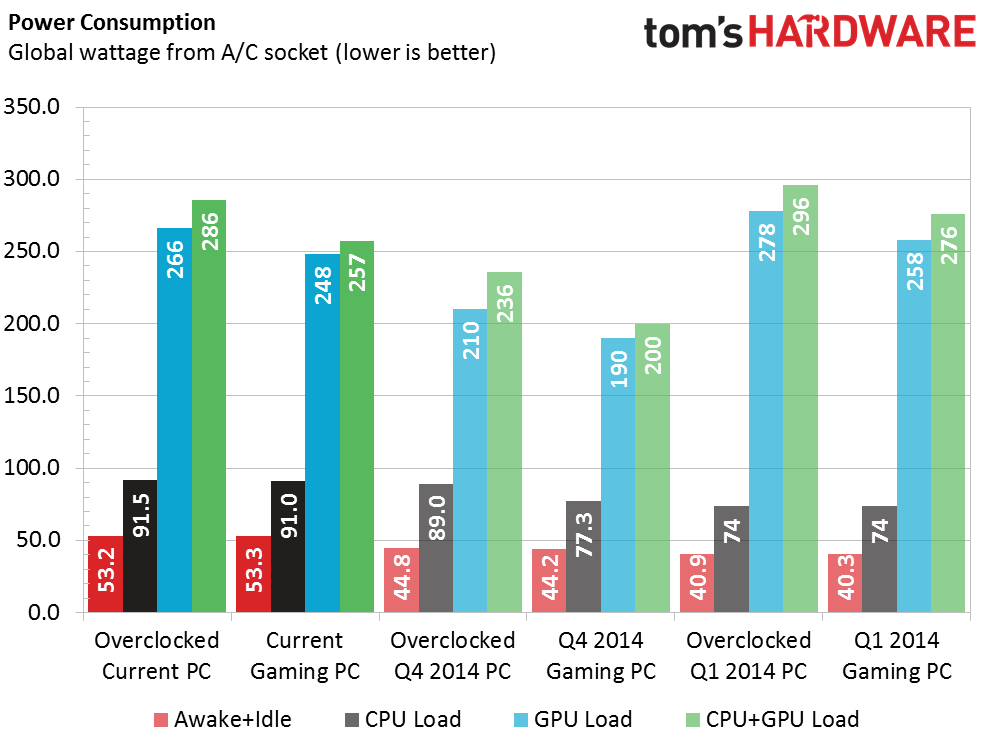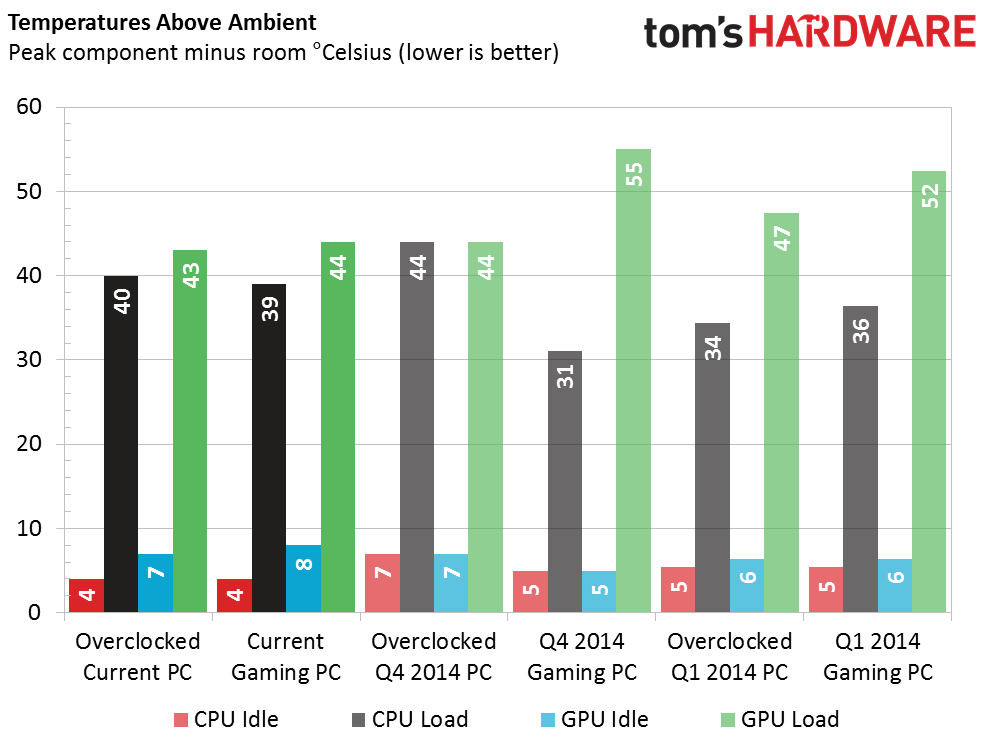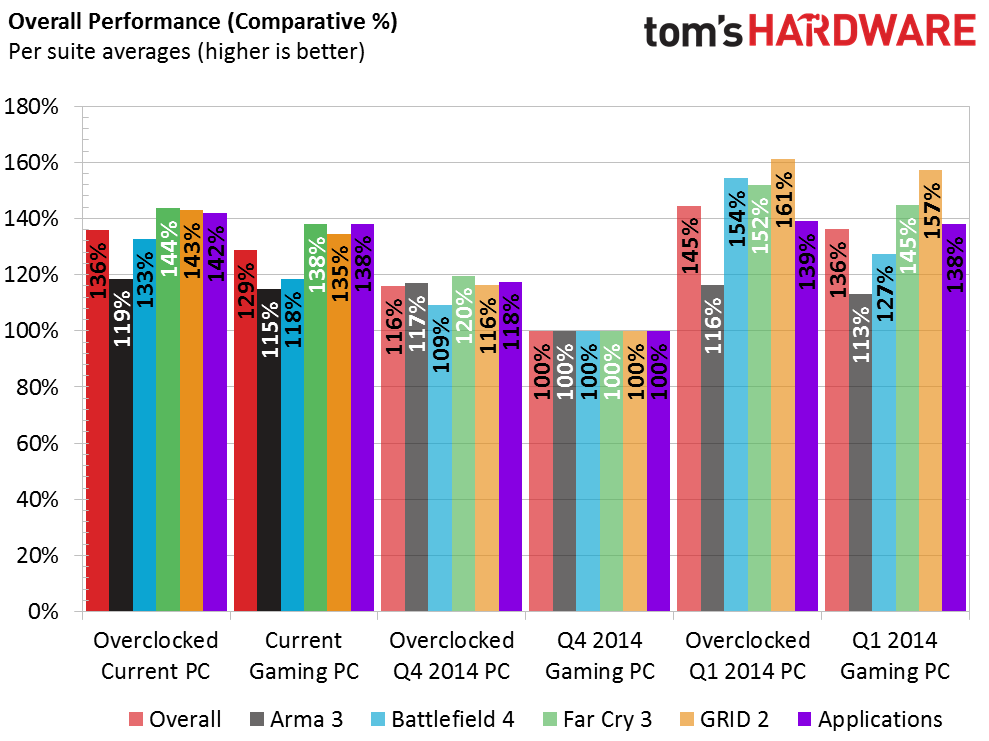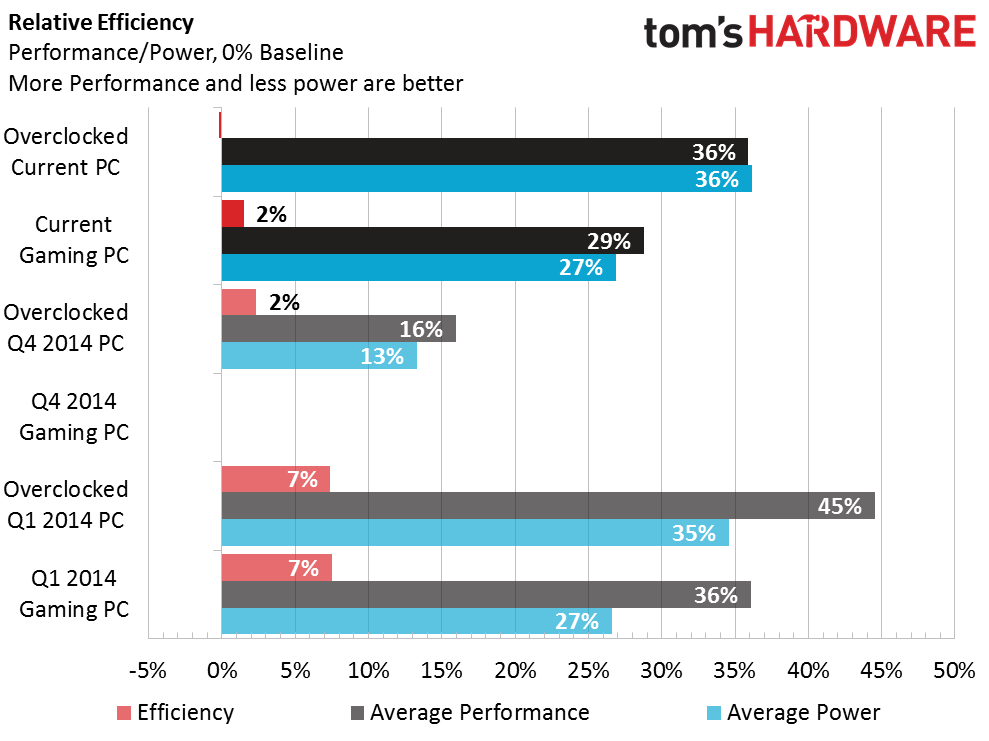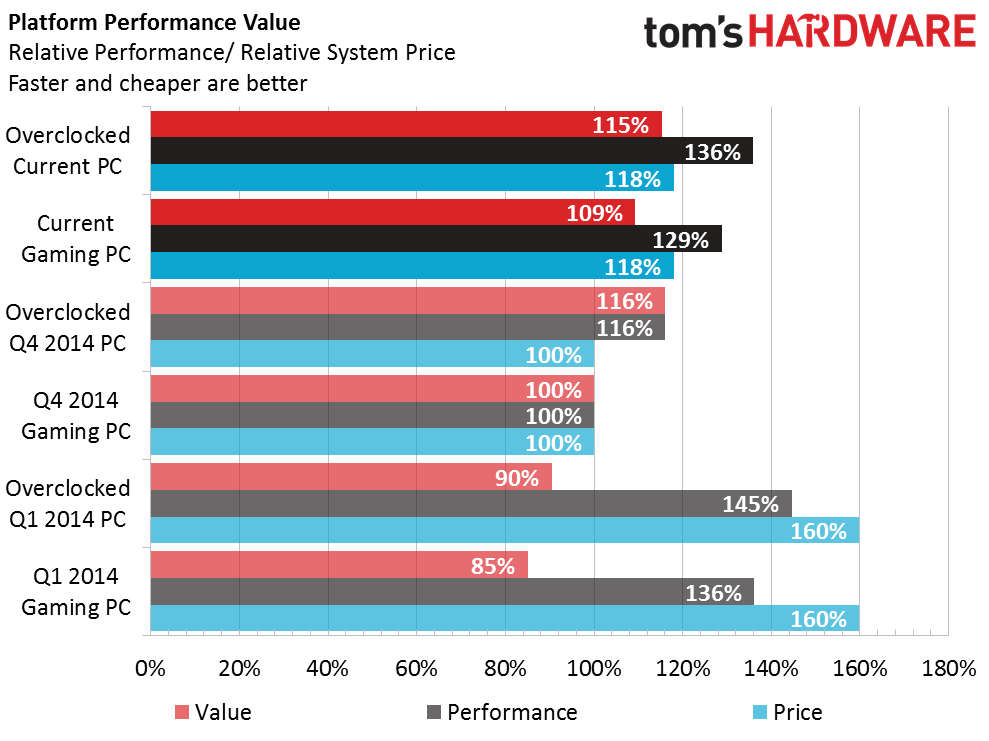System Builder Marathon Q1 2015: Budget Gaming PC
Power, Heat, Efficiency And Value
Graphics card manufacturers tend to overstate the power requirements of their products, taking into account consumption from the rest of the system and factoring in the efficiency of different power supplies.
With a fully loaded CPU and GPU, not one of these configurations pulls more than 300W from the wall. Applying an 82% efficiency figure to this quarter's overclocked system, peak output from its power supply is only about 235W. Powered by an 80 PLUS Gold-rated unit, my Q1 2014 effort consumes the least amount of power at idle and under host processor loads.
Intel’s Haswell architecture runs cool at idle. Still, it's good that the quad-core models include a more effective heat sink and fan. Intel also treats enthusiasts to this same cooler with the unlocked Pentium G3258, leaving some room for augmenting its clock rate.
None of these systems gave us a reason to worry about thermals, and each graphics card’s fan profile had reserve airflow if we wanted to pursue lower temperatures.
Since these are all intended to be gaming machines, I’ll weigh their overall performance accordingly at 80% games and 20% applications. Tallying average frame rates using every resolution puts a big emphasis on CPU performance. The current Core i3-based machine delivers between 15%- and 38%-higher numbers than last quarter’s baseline. My processor upgrade further bolstered performance in our application workloads.
The highest-performing machine also leads in efficiency, although this can be attributed largely to Rosewill's Capstone power supply. While last quarter’s conservative approach to overclocking the Pentium G3258 improved efficiency, my latest graphics-only tweaking efforts delivered the opposite effect.
Value
If you have no plans to overclock, then Intel’s Core i3 line-up is a highly capable starting point for your gaming needs. Our current performance platform starts off delivering 9%-greater value.
Get Tom's Hardware's best news and in-depth reviews, straight to your inbox.
But the true value of Intel's Pentium G3258 is only realized when you access its “free” clock rates, which helped last quarter’s tuned effort to earn a narrow victory. The oldest machine is handicapped in this comparison, as a year ago we paid $320 for its GeForce GTX 770 graphics card.
Frugality in purchasing last quarter’s enclosure increased the machine’s value position when factoring in the cost of its hardware. However, this cheap machine is the one hit hardest by the fixed $100 cost of our Windows operating system
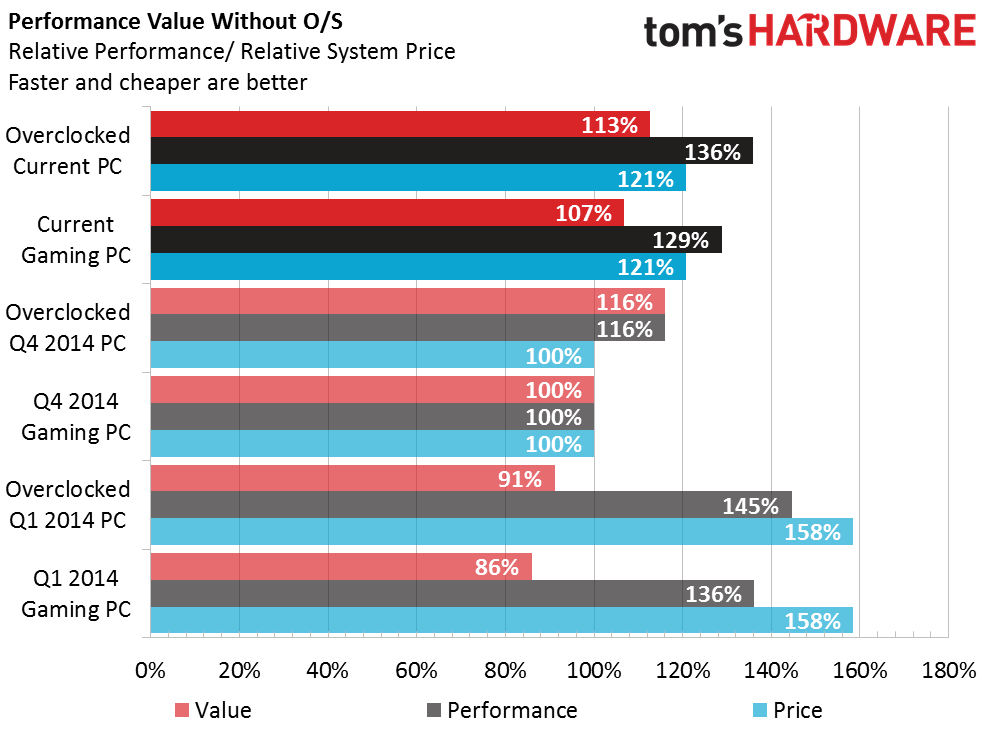
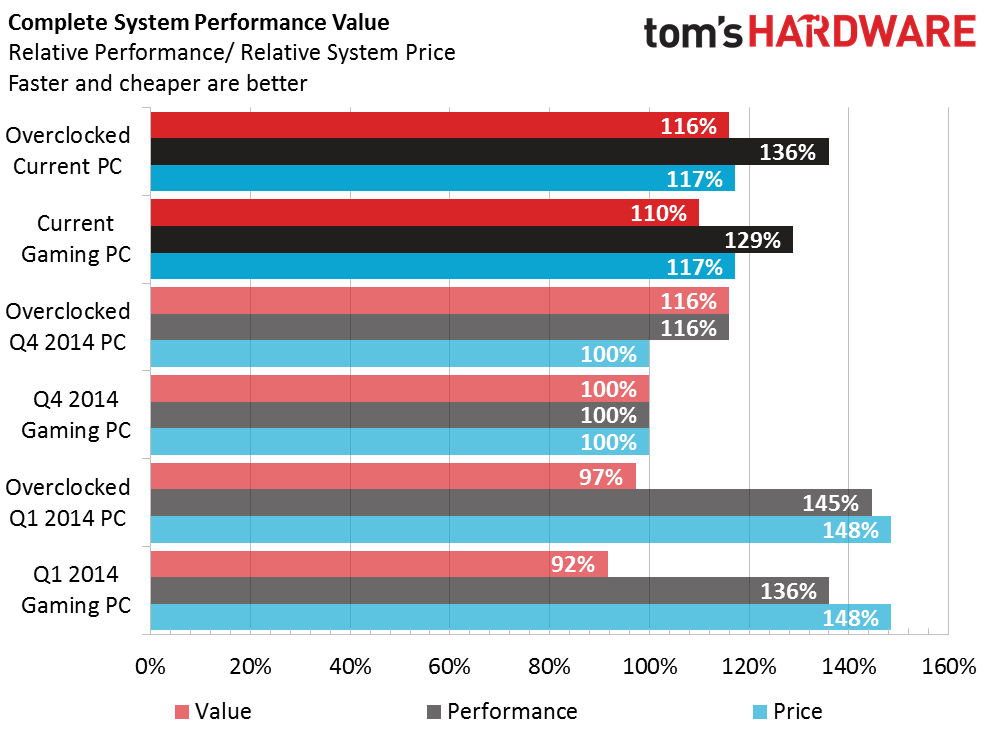
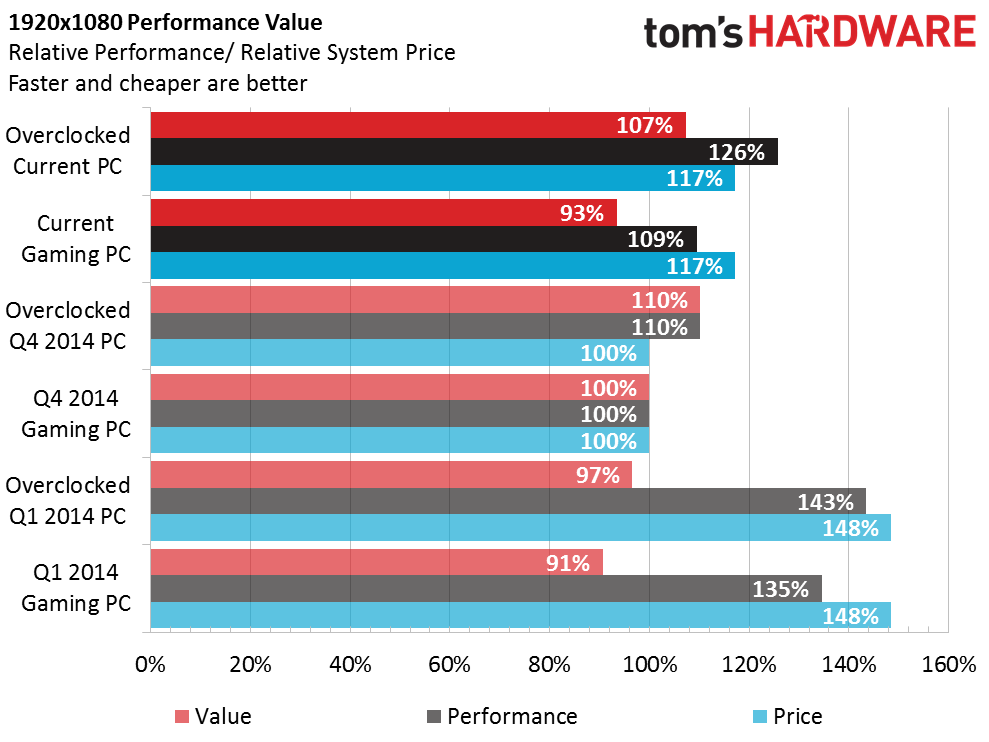
As their names imply, these three budget-oriented boxes were built to play games in Full HD. Even factoring in the cost of the operating system, last quarter’s Pentium G3258 and Radeon R9 270X pairing delivers the best gaming bang for the buck. Of course, true value is a bit more subjective, and those unwilling to drop anti-aliasing or detail settings may find the cheap machine incapable of fulfilling their needs. In giving props to the Pentium’s value, we must throw in a word of caution: the next big gaming title on your radar may not even run on a dual-core processor, meaning a CPU upgrade could be required sooner rather than later.
-
cmi86 Over all I like it. I am glad to see that you went with the superior R9 280 over the thoroughly underwhelming GTX 960, which I thought you may have felt obligated to include in the budget build. Only minor gripe I have is that I am sure you could have saved five dollars somewhere to get that SSD in there, case maybe ?Reply -
damric Should have used Windows 10 Preview instead of paying $100 for OS. It's an obvious choice for a cheap build.Reply -
TechyInAZ Reply15365194 said:Should have used Windows 10 Preview instead of paying $100 for OS. It's an obvious choice for a cheap build.
I disagree, eventually windows 10 preview will stop working when windows 10 is officially out. And for people viewing and building a duplicate rig off this post half to a year later, they would be out of luck.
Nice computer! I personally would have chosen a gigabyte mobo instead. -
Onus I didn't like it. I can't help but think I'll get lots of downvotes, but it looks like a hodgepodge of throwaway parts. By that I mean every choice was an example of "settling" for less than what was probably wanted. On a tight budget, with limited or no future upgrade possibilities, maybe it is the best that can be done. Throw in some possible future upgrades though, and I would have made some sacrifices for the benefit of future growth. For example, I'd rather see a more competent mobo (e.g. to allow a data RAID1), PSU, and storage (i.e. including a SSD), and would have lowered the CPU and/or graphics card (depending on benchmarks) in order to get there. As good as most modern games look even on a mix of "high" and "medium" settings, this would create a system with much longer-lasting core components, and snappier "home-user" performance (because of the SSD). Future GPU and/or CPU upgrades in a year or so would keep the whole system humming right along.Reply -
envy14tpe This is the best Budget Gaming PC I've seen on this site. Love the choices. Did not skimp and no overkill on one component while weak other components. For a build under $600 you could not have done better. This will max out 1080p gaming!Reply -
MerryLane Why not buy an AIO cooler with these 100 dollars and overclock the hell out of the pentium?Reply
After all the i3 has only two cores too ... and no overclocking possible.
I'm pretty sure that 50% overclocking is greater than 2 extra threads that give at best 30%.
There are also great bundles everywhere, G3258 + motherboard for cheaper.
The GTX 960 also seem more future proof than a 280 and barely more expansive. -
TNT27 Reply15366289 said:Why not buy an AIO cooler with these 100 dollars and overclock the hell out of the pentium?
After all the i3 has only two cores too ... and no overclocking possible.
I'm pretty sure that 50% overclocking is greater than 2 extra threads that give at best 30%.
There are also great bundles everywhere, G3258 + motherboard for cheaper.
The GTX 960 also seem more future proof than a 280 and barely more expansive.
Are you serious in saying that you belive a gtx 960 is more future proof? The r9 280 is on par or better than the 960, and its cheaper. When overclocked the 280 can reach into gtx 770 territory. Its also go a wider bus, and a extra gig of vram= much better performance in higher resolutions, and newer games that are starting to use that gig of vram. -
dstarr3 I've built with that case before, and it is really surprisingly good for it's cost. But I got it for $35 at my local computer parts store. Regular price. If you're paying $50 for it, you're mad.Reply -
turkey3_scratch I don't see why SSDs are being considered a necessity. With Windows 8 and the fast startup you don't even need to worry about waiting a minute, and on a budget I don't see why it's worth the extra money just to calm one's impatience for 10 seconds of loading.Reply

